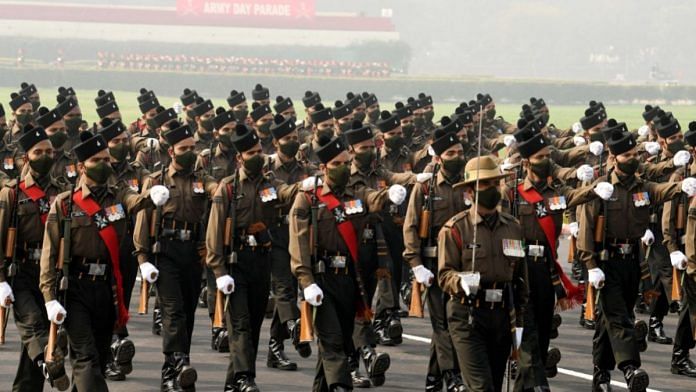This year’s Republic Day parade will feature two new things. The first is old military uniforms and the second is the new Central Vista, both being something to take pride in. As the Army contingents, dressed in part in older uniforms of the 50s, 60s, and 70s, march through the Central Vista, it is bound to make every Indian’s heart swell with pride.
Ever since I was a child, one has been hearing of buildings or structures having been constructed by the Mughals or other dynasties or the British. The Central Vista will give us the pride of this icon, this seat of power having been constructed during modern times by the Indian government and the people.
Soldier uniforms — a matter of pride
The Army contingents will showcase the older versions of uniforms – Rajput Regiment contingent wearing the uniform as it was in the 50s, Assam Regiment in the uniforms of the 60s, and my regiment, the Jammu and Kashmir Light Infantry Regiment (JAKLI), will sport our uniform of the 70s, the one that I was commissioned in. The new digital disruptive pattern combat uniform of the Army is also making its debut. Soldiers take a great deal of pride in their uniforms.
As I said in my piece in Hindustan Times, uniforms are worn for symbolic value, recognition, or uniformity by educational institutions, workplaces, or organisations. In the armed forces, however, they denote discipline, equality, and respect. Soldiers take pride and find motivation in uniforms and badges, medals, and insignia. Why do uniforms evoke pride?
An army uniform gives the soldiers their identity. The badges of your regiment give you a sense of belonging. A regimental lanyard (a regimental colour drawstring worn on the shoulder, originally to carry a whistle) bonds you with your comrades, with whom you share bonds of life and death. The medals that soldiers wear on their chests are awarded for bravery during war or other operational duties.
A medal motivates. It is also revered. Veterans too wear the medals on ceremonial occasions. Even the next of kin are allowed to wear them on such occasions after the veteran passes away. That is the kind of love, importance, and pride attached to it.
Also read: Coming to Central Vista: New PMO in Dholpur sandstone inside Rs 1,200-cr Executive Enclave
A uniform is symbol of responsibility
In ceremonial uniforms, senior soldiers wear a sash and officers wear a pouch belt diagonally across their chest, on which are inscribed all the battle honours that the regiment won in the past. When a soldier wears a uniform adorned with all these accoutrements, it evokes immense pride in them and also places a great responsibility on them. They wear on their uniform what has been achieved by their predecessors, their forefathers. It is an onerous responsibility. They cannot do anything to let them down. They will always strive to add to the good name, which can only be done by performing their duty well, even at the risk of their own life. There is no additional incentive or financial bonus for doing this. That is the ultimate motivation.
When such motivated soldiers march past the citizens, they will reassure every Indian that the worst of the pandemic is behind them, and the country, the government, and the administration are capable of taking care of its citizens. The military might on display assures every citizen that we are fully capable of meeting all external threats.
It also sends out a statement to the world about India’s capability regarding the protection that it can offer its own people and the role it can play as a dependable participant in the global community. This, in turn, evokes the confidence of other countries in its stability and leads to better economic growth and development. It sets up a positive spiral in the growth story of India.
Lt General Satish Dua is a former Corps Commander in Kashmir, who retired as Chief of Integrated Defence Staff. Views are personal.
(Edited by Humra Laeeq)






